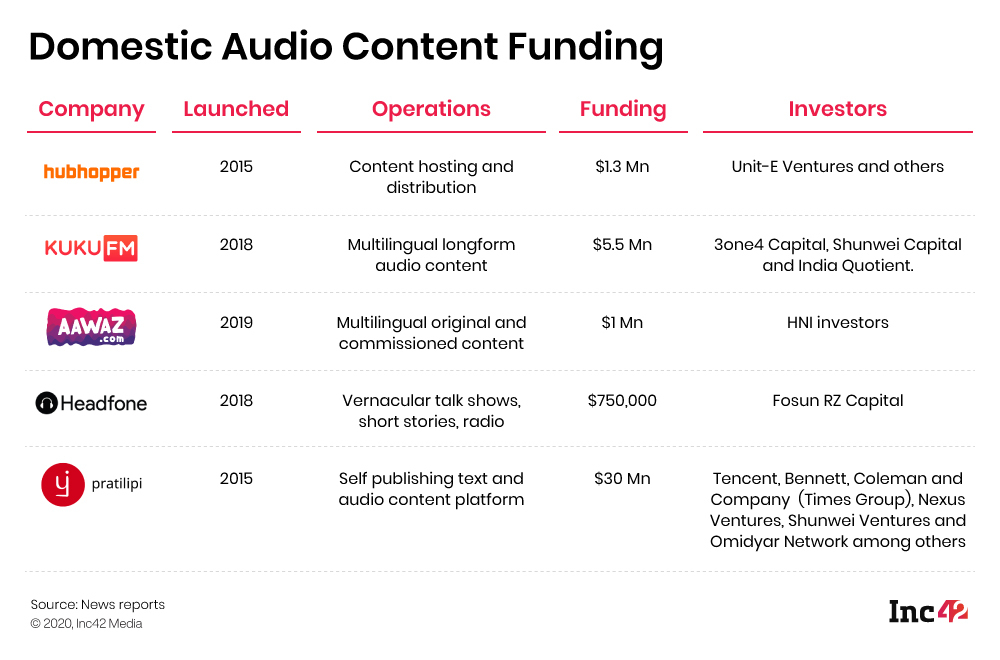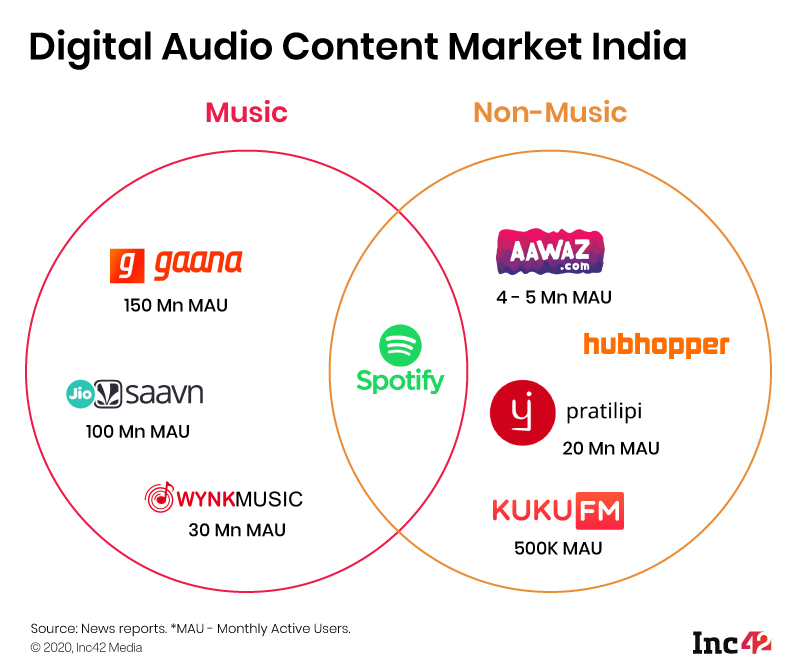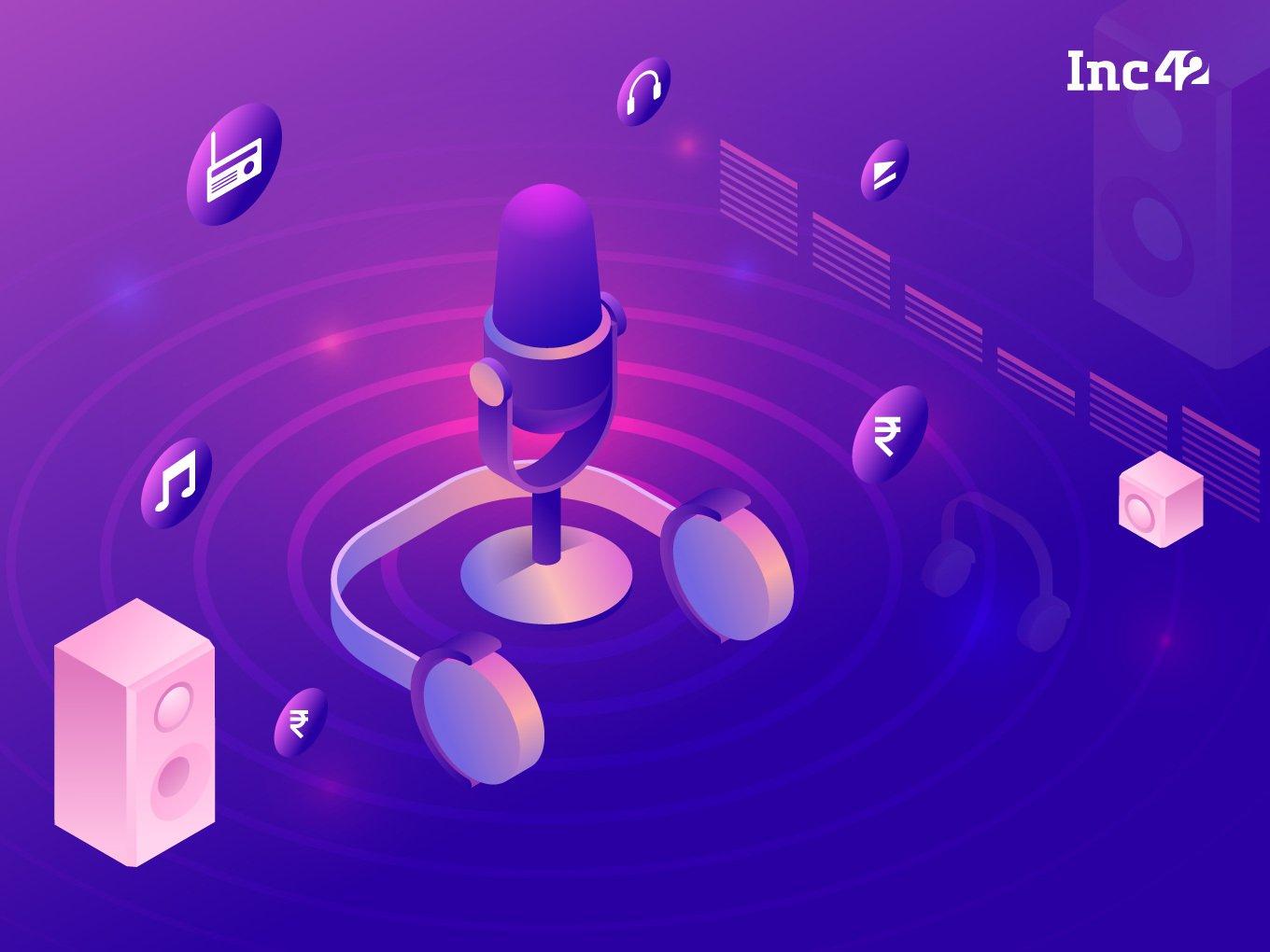Digital audio content providers are increasingly gaining popularity and funding, but their primary revenue model has not gone beyond subscription
In spite of the growing adoption of digital audio format, Indian Advertisers are yet to tap into this 200 million-plus audience base
Homegrown audio content platforms are creating their own solutions to leverage their unique reach in the country
Are we great listeners first and good readers or viewers only after that? Oral storytelling came into play much before the written text and the audio-visual is a 20th century innovation. Digital audio is the newest medium of this genre with growing listenership and huge advertising potential. So much so, that in mid-November this year, video-streaming platform YouTube announced its foray into audio advertising.
YouTube’s video-advertising business stood at $5 Bn in the third quarter (July-September) of the current year. But its sudden leap of faith into a nascent space (we are keeping over-the-air radio stations and their digital streaming out of it) sends out a clear signal – visual ads alone cannot cater to the fast-evolving consumer landscape.
Even then, the scope of raking in the audio ad dollars seems severely limited in India. According to global media advertising giant GroupM’s 2020 projections, the Indian advertising market will grow at 10.7% year on year to reach INR 91,641 Cr this year. However, 71% of Indian advertisers are spending less than 10% of their budget on digital ad investments, says Xaxis, the programmatic advertising arm of GroupM.
Globally, too, it is not a rosy situation. Even in a mature market like the US, the ad revenue generated by the digital audio ecosystem accounted for 2% of the total digital ad revenue of $124.6 Bn in CY2019. Interestingly, nearly 80% of this revenue came from audio ads on mobile devices.
What’s Happening In India
As of now, music-streaming giants like Gaana, JioSaavn and Airtel Wynk rule the domestic audio content space and offer ad-supported streaming besides subscription-based business models. Times Internet-backed Gaana leads this market with more than 150 Mn monthly active users (MAU), followed by Reliance Industries-backed JioSaavn that claims a 100 Mn-plus MAU.
But music is not the only field of attraction. With data bandwidth improving all over the country, on-demand, non-music digital audio startups such as Kuku FM, aawaz.com, Pratilipi, Khabri and Hubhopper have also seen better audience engagement across demographics. The genres are many in this segment, right from audiobooks and online story-reading to news, talk shows and self-improvement lessons. Better still, a few companies like HubHopper, Vaaka Media, Kuku FM, Podbean and Khabri also offer their users a free, end-to-end platform to create, filter, edit, distribute and monetise podcasts and other forms of digital audio content a la Spotify.
Many of these desi platforms have seen around 1 Mn MAU across a broad range of multilingual demographics and managed to attract early funding from several investors. Hubhopper raised $1.3 Mn, Headfone raised $750K, while vernacular storytelling platform Pratilipi got around $30 Mn in funding. Y Combinator-backed Khabri also scooped up seed financing from blue-chip angels such as Rajan Anandan, Kunal Bahl, Rohit Bansal, Shailesh Rao and Rajesh Sawhney.
Most of the players in the digital audio segment want to build a subscription-first approach, supplementing it with advertising and freemium content. But the question is: If consumers cannot get enough of digital audio, why are they not willing to pay for it? According to a KPMG study on the media and entertainment industry, the Indian audio streaming market comprises 200 Mn MAU, of whom just 1% are paid subscribers. It also underlines an urgent need for boosting ad revenues if the nascent segment has to grow and raise more funding from late-stage investors.

How The Metrics Challenge Plagues Digital Audio Platforms In India
“Audio advertising is a market waiting to be unlocked. It is only weighed down by the absence of quality data and formalised metrics,” says S. Swaminathan, CEO and cofounder of Hansa Cequity, a customer data analytics company.
According to Swaminathan, after the entry of Reliance Jio and the subsequent mobile data boom across the country, the demand for audio and video content has spiked as never before, but the ad pricing part remains vague.
Two key metrics exist in this ecosystem – namely, cost per 1,000 impressions (also known as cost per mille, or CPM), a format used for web pages, and cost of the time slot (prime time ads cost more) applicable to TV and radio advertising. When a web page where the ad resides is opened, it is counted as an impression irrespective of whether the ad has been played or skipped.
As brands are not yet aware of the full potential of audio – unlike videos, both passive and active listeners can easily engage with audio content – the CPM here is much lower than its video counterparts. Additionally, a wealth of data is available for tracking a video ad’s effectiveness, and hence, its premium pricing. As similar mechanisms are not available yet to track how audio ads are performing, the price points remain low. (Google claims to be working on it, but no commercial solutions have reached the market.)
In India, the CPM of an audio ad on popular music stream apps is about INR 0.16 compared to the CPM of a video advertisement, which is around INR 0.23. It means video ads are at least 43% more expensive. YouTube’s CPM rate in India starts from $0.5 (INR 35-40) and goes up depending on the ad’s ability to reach the target audience.
On music-streaming apps which feature both audio and video ads, it costs INR 0.2 for an audio and INR 0.3 for a video. Once again, videos are at least 50% more expensive, according to Swaminathan of Hansa Cequity. Effectively, video ads are about 40-50% more expensive than audio ads, but then, the cost of video production is also higher than the audio.
A look at traditional radio advertising also highlights how digital audio ads are lagging in revenue. On the radio, an audio ad costs between INR Rs 50/10 sec and INR 2,500/10 sec, based on time slot allocation and listener reach of the show.
To complicate matters further, the CPM or the time slot metric cannot fully justify the reach of an advertisement in the non-music space as the level of listener engagement has to be much more specific.
According to Sreeraman Thiagarajan, cofounder and CEO of aawaz.com, an on-demand audio and podcast network, the major difference here is the ‘completion rate’ of the content compared to ‘views’.
Just because people click on a web page or a video where ads are displayed or streamed, it does not mean they will watch the entire ad. They may skip it half-way. However, podcasts are designed with a specific user base in mind, and the audience is more likely to listen to an in-content ad or engage better with native advertising (where a host endorses a brand).
When advertisers in India expand beyond traditional audio media buying and opt more for digital formats, the next step will be programmatic audio that can help achieve a measurable ROI, says Chirag Chandiramani, AVP, Client Operations, at Merkle Sokrati, a digital ad technology and big data analytics firm.
This technology will enable brands or agencies to purchase and insert ads on a publisher’s site/s or app/s within milliseconds through a sophisticated software ecosystem and help them go beyond simple demographics. In simple terms, it will not only ensure a better reach but also better ‘conversion’ unlike other ad formats.
“Digital audio holds advantages over video as there is no competition for ‘hearability’ and the advertiser has the listener’s full attention. It is a medium that creates an emotional connection and also provokes the user to take the next step in the purchase cycle,” he adds.

Has Spotify Hit The Sweet Spot?
Even though most audio platforms in India and abroad are struggling to pitch to advertisers, that does not seem to be the case with Spotify, say advertising experts. The Swedish music-streaming giant boasts a premium advertiser base across major categories, including high-end automobiles, fashion, FMCG and OTT. For some years now, the company has hit the sweet spot of digital audio strategy, strengthened further as India became its latest market of interest. The company registered a 29% year-on-year (YoY) growth in MAU and reached 320 Mn in the third quarter of 2020 with 10% of its €1,975 Mn ($2,400 Mn) revenue being ad-supported.
Interestingly, Spotify uses the CPM as a metric for ad sales on its music-streaming platform although it currently offers ad-free podcast services in the Indian market.
“Advertisers come to us to target the Gen Z and millennial listener base. Our advertiser base consists of premium brands who are early adopters of new formats globally,” says Arjun Kolady, head of sales, Spotify India.
According to him, the platform’s ability to demonstrate completion rates of ads has helped rope in brands such as Mondelez, Adidas, Jaguar and Netflix, among others. The company, which has made a large number of global acquisitions in the ad and audio tech space, is now working on more easy-to-use ‘self-publishing’ audio ad products to expand its advertiser’s reach.
How Audio Platforms In India Are Working To Boost Ad Revenue
Right now, India is embarking on its digital audio ad journey and very few ad dollars are coming in. In fact, most of the advertisers allocate less than 8-10% of their advertising spend on audio advertising, Chandiramani of Merkle Sokrati tells Inc42. But businesses in the digital marketing space are steadily building their customised solutions.
Although subscription remains their core model, Indian audio content platforms are also building advertising solutions to tap into this growing market. For instance, the likes of Hubhopper and aawaz.com are inserting ads within the narrative and promoting partnerships through sponsored shows. This model has been successfully implemented by several audio-streaming businesses, including Spotify, in mature markets where advertisers buy spots within the programme and a trusted voice talks about the product. Consider it an advanced form of influencer marketing.
This native advertising model has also been implemented by Lizhi FM, the second-largest podcast platform in China. It claims to have 46.6 million MAU and primarily generates revenue by selling products in a way WeChat does.
While aawaz.com has sponsored content from the likes of IBM and Agora, it is working on an in-house audio programmatic solution as well. “Currently, we have 4-5 Mn users per month. But we expect our programmatic solutions to be monetisable when we have 4-5 Mn daily users,” says Thiagarajan of aawaz.com. The startup also licenses its content on other platforms like Spotify.
Mumbai-based vernacular podcast platform Kuku FM, with more than 500K MAU, is following a similar route for monetisation and expects it to be market-ready by 2021. “Subscription will be our chief mode of revenue generation,” affirms cofounder Lal Chand Bisu. “But given that the CPM on non-music audio can be 10x more for serious listeners, as per our research, advertisers will certainly come in soon.”. Just like his industry peers, Bisu thinks there will be better clarity on the monetisation models by 2021.
According to Gautam Raj Anand, CEO and founder of Hubhopper, a podcasting and audio-on-demand platform, listeners do not appreciate long-format ads and podcast listeners are so discerning that they would much rather have their favourite speakers talk about brands for 15-20 seconds. Moreover, this kind of native advertising is in-line with the content at present. So right now, it cannot be changed dynamically from one platform to another with the help of programmatic solutions. Hubhopper currently has brands advertising through podcast creators on its platform and gets a share of the ad revenue.
The emergence of a huge market comprising ‘hearables’ or smart audio devices and connected devices has also made audio content easily accessible. Whether you ask Alexa to play your favourite music while you are cleaning the house or listen to a podcast on climate change while cooking, the screen-free medium is increasingly gaining popularity.
“There has been tremendous growth in the voice technology segment where users can engage with a brand through voice assistants. That is why native ads on podcasts commonly promote audio equipment brands,” says Anand of Hubhopper.
Moreover, the type of content can also determine the kind of ad people would want to hear. An ad with high-tempo electronic beats would not be welcomed during a guided meditation podcast.
The Way Ahead
Digital marketing solutions and platforms have been widely adopted by all and sundry, from big businesses to niche boutique brands to neighbourhood stores, thanks to the prevalence of a favourable tech ecosystem where publishing digital ads or purchasing impressions on Google or Facebook can happen in a few clicks. But that is not the case with the audio.
One key advantage of web and video advertising is that the ‘click to buy’ button makes the users’ interest in the brand easily measurable. Audio ads, too, need similar features, especially for multilingual users, because vernacular users will grow faster than English-language users. A Google KPMG report has also stated that vernacular internet users are expected to grow at a CAGR of 18% to reach 536 Mn by 2021 while English-language users are expected to grow at 3%, reaching 199 Mn in the same period.
Brands can also use audio to strengthen recall value with customised audio campaigns in a language-agnostic manner, say experts. “Remember the Windows 95 startup sound? These sonic (audio) assets are generally easy to remember, often humanising trivial and ‘hidden’ aspects of a brand’s identity along the way,” Niraj Ruparel, head of mobile and emerging tech at GroupM India and head of voice, WPP India, tells Inc42.
According to him, such customisation will not only improve user experience but also fortify brand engagement with users who cannot read banner ads. This opens a whole new market for text-to-speech solution providers as well. There is more innovation scope in the audio advertising market than meets the eye.
So, what types of brands are currently advertising on this medium?
OTT advertisements are the most commonly heard creatives on music-streaming platforms. But the market is skewed beyond OTT. As mentioned before, Spotify currently has premium advertisers on its platform, right from top automobile, technology, FMCG and OTT brands. But direct-to-consumer (D2C) brands and localised advertising segments, which have driven the growth of Facebook, Instagram and Google ads in the country, is a market up for grabs.
Spotify already has a big chunk of premium advertisers. Can Indian platforms offer suitable ad solutions which will build a connection with Bharat?
































 Ad-lite browsing experience
Ad-lite browsing experience